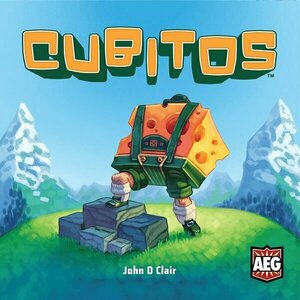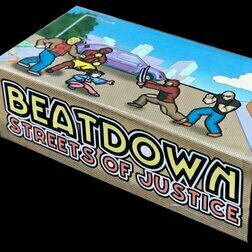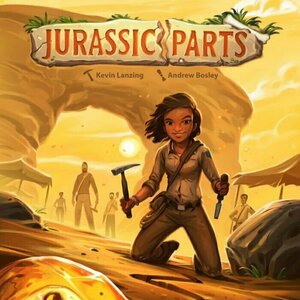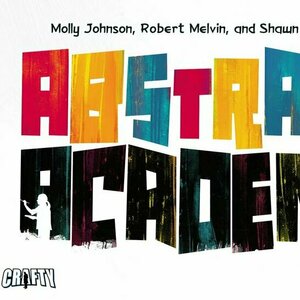Purple Phoenix Games (2266 KP) rated Cubitos in Tabletop Games
Mar 17, 2022
Cubitos is a push-your-luck, dice building, racing game for two to four players. In it, players have runners that will be moving around a crazy race track, and another runner who keeps track of fans (the manager maybe?), and the first player’s runner to cross the finish line will be the winner! Now, managing movement and special abilities is where the game REALLY is, and it all boils down to which special dice are purchased and used, and whether Lady Luck will find favor or not. It’s a wild ride, so prepare your runner and let’s go!
To setup, place out one of the double-sided Racetrack boards, along with the Fan Track board. Runners for each player are placed at the Starting Line on the Racetrack board, and the other on the bleachers of the Fan Track. Each player receives a color-coded Player Board and nine gray starting dice. They receive a Phase Token to keep track of each phase in a round, and the starting player receives the Start Player Die. Each dice box is placed around the boards with the dice on top. All corresponding cards for each die type is placed by the dice box, and the game may now begin!
DISCLAIMER: We have adopted an unofficial variant/house rule that differs from the rules because we find it works better for us. During the phases where all players may play simultaneously we instead just have each player take a turn individually. -T
A turn in Cubitos is divided into two main phases with several sub-phases for each. During the main Roll Phase, players will first Draw dice from their personal Draw Zone (on the Player Board) and place them into the Roll Zone. Initially, players will have a hand size of nine, but that may be adjusted as the game progresses. Once the dice have been drawn the player then Rolls their dice. Every die face showing an icon is counted as a Hit, and every die showing a blank face is considered a Miss. All dice showing Hits are moved to the Active Zone of the board, and the player then decides if they wish to Push (their luck) and re-roll all the Misses in hopes of more Hits, or if they are done rolling. Once a player re-rolls their Misses, if the result is all Misses, the player Busts and must move ALL rolled dice to the Discard Zone on their board. However, players may continue to roll all Misses until they Bust or are content and stop.
The Run Phase then begins with players resolving their red die icons (crossed swords for attacks), and determining their other icons rolled for coins and movement. Feet icons (and certain dice special abilities) provide players with movement along the Racetrack board, and coins provide the player with purchasing power to buy new dice. Once a player’s Runner has landed on a reward spot on the board, the player receives the benefit and moves all dice used this turn to the Discard Zone on the Player board.
Every time a player Busts, or lands on a Fan icon on the Racetrack, the other matching Runner on the Fan Track board will move one spot along the track, and the player receives the benefits of the new space. These benefits are either an increase in hand limit of dice drawn, or more purchasing power in the form of credits. Reward spaces on the board could give players extra dice for free, allow players to remove dice from their collection, or even gain credits to be used at any time. The game continues in this fashion of each player taking their turns until one player crosses the finish line and wins!
Components. This box is chock full of tasty components that we all just adore. The boards and cards are all good quality and feature some fantastic art, and the custom dice are just so fun to handle. A truly ingenious use of folding arts is used when setting up all the dice boxes. Not only are they used in-game to remind players what icons are on each die face, but they also hold the dice during play, and store the dice in the box. I mean, triple duty dice boxes are where it’s at! Everything is super colorful and just a joy to play with each time. My one quibble is the very offensive block of cheese on the box cover. I am a big Chicago Bears fan, and seeing something so proudly displayed that even remotely resembles an homage to the Packers is such a shame to me. I really hope that wasn’t intentional, but I am also joking. Mostly.
The absolute best part about this game is the selection of action cards associated with each special set of dice. For example, the purple dinosaur dice could be paired with seven different cards, each with different abilities when the icon is rolled. Each color has a seven card deck, from which a card could randomly be used each game. The rulebook also offers 10 suggested combinations of cards, and also invites players to choose their own combos. This reminds me of a similar mechanic I first saw with the Dice Masters system, where each die’s faces could mean something completely different depending on the card associated with it. I loved that mechanic back then, and I do now as well.
I cannot believe I passed on this game for as long as I did. I mean, I like AEG-published games. We have reviewed John D. Clair games positively: Mystic Vale, with Custom Heroes and Space Base coming soon. Was it a subconscious dislike for the dumb cheese man on the cover? I am not too sure, but I am clearly glad to have it now. The cool dice. The interesting theme. The multi-use dice/card components. The fact they included both orange and purple dice. Am I into racing games now? The reasons are plentiful, and I just cannot wait for my next play of Cubitos. Maybe I can get my wife into it and it can be a staple in our rotation.
There are several other little rules that I did not mention here, but all in all I have had a blast every time I play Cubitos. I was certainly correct in wanting to add it to my collection, and having Josh teach Laura and me originally just adds a unique personal touch to the game for me. Creating lasting memories is a big reason I am so into board games in the first place, and I think Cubitos will hold a special place in my heart simply because I was able to play it with my best friends. They agree with me that this is a special game, and Purple Phoenix Games gives this a nonsquare 16 / 18. If you see this at your LFGS I highly recommend you pick up a copy. Don’t wait, like I did, because when you do get around to it, they just may be out of stock. And a suggestion: because the cheeseperson is wearing lederhosen, just refer to them as a great German friend. AND THAT’S IT. Go Bears.
Gareth von Kallenbach (980 KP) rated Slender: The Arrival in Video Games
Jul 4, 2019
“The Slender Man (also known as Slenderman) is a fictional supernatural character that originated as a creepypasta internet meme… Stories of Slender Man commonly feature him stalking, abducting or traumatizing people, particularly children. The Slender Man is no confined to a single narrative, but appears in many works of fiction, typically composed online.”
Slender: The Arrival (which we’ll just refer to as The Arrival moving forward) is the official video game adaptation of Slender Man. Blue Isle studios developed the game to bring us improved visuals, great replay value, and a brand new storyline. These should combine into survival horror at its best. But sadly, it does not. The Arrival encourages exploration and the philosophy of scaring the living daylights out of you. It just doesn’t. Now, truth be told this genre is not typically my bread and butter, but I came into this game with hopeful expectations, but soon found myself wanting more than the game could offer.
First, you are thrown into the game without any instruction or opening. Just head down the road, though. It seems easy enough. I did appreciate the way they worked credits into this opening sequence though, as you are shown the developers and the team that worked on the game. Once you get through this, you come upon a house where you will explore the rooms to find notes scattered throughout the house giving you more information on your back story. Sparing spoilers, essentially the story revolves around a shared trauma from your youth. Once you leave the house, you press on, turning on some generators along your path.
You’ll come across the second house after crossing a river, where I encountered some of the strangeness I assume is part of the experience. Glitching visuals, weird creatures that seemed to disappear when you shine your flashlight upon them, that sort of thing. It could have been a bug, or bugs, but doing a little digging online it seems I was not the only one to experience the same. There wasn’t really any action to be had. A little disheartening.
There’s not much challenge with The Arrival. You will, at some point, encounter the Slender Man in the game. I went straight toward him, and nothing really happened. Unfortunately, it’s a bad byproduct of these games. If it doesn’t scare you, even in the slightest, you’re just left with a stagnant experience while you are running from point to point to read lore.
It took me nearly 2 hours to finish the game, though I suspect those without toddler twins may get through it a bit faster. Suffice it to say, I wish I had those 2 hours back. I never really felt the tension that would cause fear or even nervousness. The shaky cam visual of the game certainly didn’t help. Essentially, you are playing through the eyes of the camera you are holding, complete with “recording” indicator and battery level (you can turn this off). As you walk the camera bobs back and forth a little bit, and as you run it does so a little faster. I understand what they were trying to accomplish here, but it was executed so poorly. I found myself constantly trying to correct this with the joycon thinking it was simply drift. It was super distracting.
Slender: The Arrival failed to give a complete game worthy of the price tag, even at its current price tag of $9.99 on the eShop. That’s not to say you won’t enjoy it, especially if you scare VERY easily or are just a fan of the Slender Man himself. It’s just that combine a wonky control system, very little instruction, and no real tension building moments, and you have a dud of game in my book.
1 out of 5
http://sknr.net/2019/06/28/slender-the-arrival-for-nintendo-switch/

Sentinels of the Multiverse
Games
App
=============================== “This is a must have addition to your digital board game...

VPN- Unlimited VPN Shield Pro
Reference and Productivity
App
'VPN' is our advanced but yet simpler version of 'FreeVPN.io', which combines lighter weight app,...
Purple Phoenix Games (2266 KP) rated Beatdown: Streets of Justice in Tabletop Games
Nov 12, 2019
Beatdown: Streets of Justice is a cooperative, push-your-luck, fighting card game that pits you and your team of heroes against waves of thugs and a boss fight. As it is cooperative, the players win by beating the boss (typically in the third wave of fights), or lose by being all knocked out. Silly heroes.
DISCLAIMER: We were provided a copy of this game for the purposes of this review. This is a retail copy of the game, so what you see in these photos is exactly what would be received in your box. I do not intend to cover every single rule included in the rulebook, but will describe the overall game flow and major rule set so that our readers may get a sense of how the game plays. For more in depth rules, you may purchase a copy online or from your FLGS. -T
To setup, each player takes a player mat, chooses a hero to play, and takes the dice of matching color to use during the game. Shuffle all the different decks of cards and place them on the table within easy reach of all players. The Attacks deck will include the base attack cards plus all cards that match the players in the game (like Invicta’s attack cards if she is in the game). Place tiny clear cubes on your starting health, as well as the starting health for the thugs you will be fighting in Wave 1, and you are ready to play!
Beatdown: Streets of Justice (or just Beatdown from now on) is played over three waves of fights where the heroes will play cards and do their fighting and then the bad guys will take their turns to fight. Generally, play will go like this: on a player’s turn they will play a card from their hand or one blindly from the top of the Attack deck. This is the opening to their “combo.” The Attack cards will typically have a damage amount and a combo rating number. In order to play more cards to the combo, the player will need to roll their d10 and roll a number equal to or higher than their accumulated combo rating (the little numbers showing in the green arrows of cards played + the green arrow number on the hero card). A combo can continue as long as the player can roll higher than their combo rating, but a failed roll doesn’t necessarily mean c-c-c-combo breaker, but rather that the hero has left themselves open for attack by the thugs. I won’t go into any more detail on fighting, as the rules are a little complex and I will let you discover those for yourselves.
After the heroes have taken all their turns, if thugs are still on the battlefield, they will now take their fighting turns. Flip over an Enemy Attack card from the deck for each enemy and resolve it against the heroes. Each baddie will make their attacks and if heroes are still conscious another round of the wave will begin. New thugs do not enter play, as they only populate at the beginning of a Wave. The thugs are no joke, and the bosses are even rougher. Can you be defeated? Yes. I was defeated in my first game. Can you be revived? Yes. Between Waves the players can participate in a Shopping Phase where they can use trophies (the cards of enemies they have defeated) to purchase health back, revive a fallen hero, or purchase a revealed Loot card to help in future fights. Play continues in this fashion for three Waves until the heroes complete the Boss Wave (by defeating all enemies) or all the heroes are knocked out.
Components. I have some good news and bad news here. Good news first. The dice are great. The tiny clear cubes are… tiny and clear. And they are just fine. The cards are good quality, as are the cardboard mats and tokens. The card layout is good too. The bad news: the rulebook is a little confusing for the first couple read-throughs and the art style does nothing for me. I appreciate the way the rules are very informal and make several chuckle-worthy jokes, but I feel like it could flow different and more efficiently. Similarly, in an industry where art can really make a good game great, this one is lacking. It’s really a shame, because everything else about the game is really good quality. The iconography is… fine, but the character art in-game is an issue I have with this.
Beatdown is actually a really decent game once you are playing. The rulebook needs work, and the art needs an update, but those grievances aside, Beatdown is an enjoyable experience at the table. I usually play pretty conservatively in push-your-luck games, but I went all out with this one and was more often than not rewarded handsomely for it. If your group enjoys cooperative, push-your-luck, fighting, card games give this one a look. Just don’t pay attention to the character art. This all said Purple Phoenix Games gives this one a 6 / 12. Improve the rulebook and art and that rating improves.
Purple Phoenix Games (2266 KP) rated Jurassic Parts in Tabletop Games
May 31, 2021
Jurassic Parts is an interesting mix and spins of area control, enclosure, and set collection for two to five players. In it, players are all paleontologists bent on claiming the biggest and best bones from a giant slab of rock containing dozens of dino species. The catch? Each paleontologist is trying to claim the bones for themselves. Sharp wit, good luck, and a bevvy of sharpened chisels spells success and fame for the paleontologist who wins at collecting Jurassic Parts.
DISCLAIMER: We were provided a copy of this game for the purposes of this review. This is a retail copy of the game, so what you see in these photos is exactly what would be received in your box. I do not intend to cover every single rule included in the rulebook, but will describe the overall game flow and major rule set so that our readers may get a sense of how the game plays. For more in depth rules, you may purchase a copy online or from your FLGS. -T
To setup, set aside one of the Pile of Bones (a wild card, of which there are several in the game) and shuffle the rest of the tiles. Split them into two stacks, flip one stack face-down, and build a slab around the Pile of Bones set aside earlier. This creates the slab of rock the players will be splitting. Each player receives their choice of paleontologist character sheet, chisels in their chosen color, and any pre-start resources per the rulebook. The slab is now ready for splitting!
On a turn, the active player will have several options. Firstly, however, the player must sharpen three chisels by moving them from the Dull Chisels are on the right of their sheet to the Sharp Chisels area on the left. Now the player may place their chisels anywhere on the slab, as long as it is on the gap between two tiles. The purpose of this is to create a wonky line of chisels that will break off sections of the slab from the larger chunk. Players will need to beware of rock piles on either side of their preferred placement, as each rock icon on either side of the placement will require an extra chisel to be dulled and discarded. If a chisel placement would cause a line to be completed, a hunk of the slab is separated from the master slab. Players consult with the line of chisels (as shown below) to determine which player has contributed more to the split than the others. This will rank out all contributing players. The player with the most chisels contributed will be able to claim their choice of HALF of the tiles split off, rounded UP (so a player would receive five tiles from a nine-tile split). The next player in contribution order will then have their choice of HALF of the remaining tiles, rounded UP (so the second player would receive two tiles from the previous example, as there would be four left). Subsequent players would then receive HALF of what is left until all tiles have been claimed, or there remains just one tile. This final tile is then given to the Field Leader for his collection.
In addition to this splitting and claiming on a turn, the active player may also make transactions with the Field Leader at any point during their turn. Actions that can be taken while transacting with the Field Leader are selling one tile to him in exchange for an Amber piece, spending Amber to: ignore rocks on the subsequent two chisel placements, sharpen two additional chisels this turn, take any of the leftover fossil tiles from the Field Leader, or take any fossil tile from the slab (as long as it doesn’t create a split). The first action from the Field Leader will cost the player one Amber. Should they wish to enact another action, its cost is two Amber. Subsequent actions on the same turn cost three Amber each.
As you will notice, fossil tiles from the slab will show plant fossils, Pile of Bones (wild), or actual bones belonging to specific dinosaurs. These specific bones will show an alphabetic letter pair icon to denote to which dinosaur it belongs. If, at the end of the game, players are able to assemble the correct type of fossil tiles belonging to specific dinosaurs, they will score many more points than if the dino skeleton were incomplete. For example, at the end of the game, each fossil tile is worth 1VP if from an incomplete skeleton. However, should a player have completed a Velociraptor skeleton, they will receive 4VP for those two tiles. A completed Triceratops scores 7VP, a T-Rex scores 10VP, a Brachiosaurus scores 15VP, and a tiny Pterodactyl scores 1VP for a complete skeleton because it spans only one tile. The Pile of Bones tiles in the game can be used in place of any other fossil tile to complete a skeleton, and Plant tiles score increasingly more points for a larger collection of them.
Play continues in this fashion of sharpening and placing chisels, breaking off sections of the slab and claiming fossil tiles, and utilizing actions at the Field Leader until all slab tiles have been assigned. The player with the most points from complete and incomplete skeletons and plants will be crowned the winner and the greatest paleontologist in the land… until the next playthrough.
Components. You know how you come to expect certain things from publishers, and can just imagine the quality of the game you are about to receive before seeing it? Such is the case with 25th Century Games. I KNOW that I will be receiving a quality product every time, and this certainly is no exception. The fossil tiles are great and sturdy. The chisels are neatly-designed and multifaceted (which I appreciate, as it would be easy to include tubular chisels and have them rolling around the table everywhere). The amber bits are the typical gemstones you find in Century: Golem Edition, but are the absolute PERFECT color and usage for this game. And did you see that first player marker? It’s a mosquito inside a polished amber stone. I mean, COME ON! How perfect is that? I’m excited just TALKING about the components. I haven’t even touched on art yet, and this is longer than most of my components paragraphs. The art is fabulous. It fits the game and the theme so perfectly – I could not have chosen a better fit myself. Has 25th Century Games set the bar too high for themselves, or will they continue to offer high quality games from here on out? I cannot wait to find out!
So sure, it looks great, but what about the gameplay? Do the art and components merely shield a mediocre game? No. Not at all. Being able to place chisels anywhere you like on the board offers players a freedom that is refreshing, but weighing that against the pressure to contribute to an existing or emerging line of chisels so that you are included in the split is just wonderful. Contemplating turns to sell off fossil tiles in order to earn enough amber to gain more chisels, or bypass rocks, or simply take the perfect tile for your collection offers just enough tacticization (why isn’t that a word…) to warm up the brain without indulging the AP in some players.
This is not at all a heavy game, and it certainly doesn’t need to be. It is just a fun time with friends and family that utilizes interesting twists of mechanics that I enjoy. It feels reminiscent of several games (hints of Through the Desert and a twist on I Split You Choose), but it entirely its own design. Purple Phoenix Games gives this one very rewarding 10 / 12. I generally enjoy most dinosaur-themed games, I understand, but this one sits among the best I have played. If you are looking for something that feels both familiar and fresh, with incredible art and components, you need to grab a copy of Jurassic Parts. There are just so many interesting choices to be made and strategies to attempt. I think I will setup a game right now. Want to come play?
Purple Phoenix Games (2266 KP) rated Abstract Academy in Tabletop Games
Feb 25, 2022
Abstract Academy is a card laying, hand management, pattern building game for two to four players. In it, players become art school students trying to impress their teachers. The only problem is that they must share a canvas, as the costs of school allow them very few luxuries. The player who can most effectively build masterpieces and satisfy all tested requirements over three rounds will ace the class and claim victory over the other starving artists.
DISCLAIMER 1: We were provided a copy of this game for the purposes of this review. This is a retail copy of the game, so what you see in these photos is exactly what would be received in your box. I do not intend to cover every single rule included in the rulebook, but will describe the overall game flow and major rule set so that our readers may get a sense of how the game plays. For more in depth rules, you may purchase a copy online or from your FLGS. -T
DISCLAIMER 2: My current temporary housing did not want me to have great lighting for photos in this review. Please try to ignore the yellow tint; I do not enjoy over-editing game photos.
To setup, shuffle each deck type and place the decks on the table. The rulebook does not specify where, so just throw them wherever. This is a game about art, so be creative. Each player draws a hand of three Canvas cards (with the whitish back and colors on the faces). The starting Teacher’s Pet player will then reveal cards according to the round from the respective decks, per the rules and provided reference cards. Each round will reveal different sets of Assignment and Professor cards. Players also draw one Inspiration card and the game is ready to begin! Paintbrushes at the ready!
Turns could not be simpler: Play a Canvas card, and then Draw a Canvas card. Both of these actions are self-explanatory, but let me expound on this a bit. Once the first Canvas card has been played by the current Teacher’s Pet, each subsequent card must be played orthogonally adjacent to another card on the table. To define the size of the entire project’s canvas, players will be confined to a 4 x 4 grid of cards. Once a column (the cards that would lead a path to the opponent) has been completed with four cards, the rows gain special rules. Firstly, the row closest to each player becomes the “Home Row.” Players may only play cards into their own Home Row, unless the only legal place to play a card is in the opponent’s Home Row. Secondly, the Home Row and the row above it is now consider the Scoring Zone, and will dictate which cards are able to be used to satisfy Inspiration, Professor, and Assignment requirements for VP. Therefore, until the 4 x 4 grid has been solidified, players are unaware which cards may end up in their Home Rows or Scoring Zones!
Victory Points are earned by scoring the special requirements of Inspiration, Professor, and Assignment cards once the entire 4 x 4 grid of Canvas cards is complete. Oftentimes players will need to compare scores to determine which player earns the points. For example, the Moret Professor card states that five VP are earned when the player controls the “most color areas with four or more quadrants.” Each Canvas card is divided into four quadrants, and quadrants are colored with one of the primary colors. A “color area” is simply a connected network of the same color within the player’s Scoring Zone. So, to satisfy Professor Moret, the player who controls the most amount of color areas that are four quadrants or larger.
Assignment cards come in Red, Blue, and Yellow, and pertain to those colors. For example, the red “Get to the Point!” Assignment requires the “most red areas with only one quadrant.” So the assignment is asking players to dapple their canvas with unconnected red quadrants.
In stark contrast, the Inspiration card requirements resemble shapes of quadrants, as opposed to colors or numbers of quadrants. Most of the shapes on these cards are reminiscent of Tetris-style shapes, where players will score their Inspiration cards by building the correct shape of connected quadrants of the same color within their Scoring Zone.
Once these cards are all scored for the round, the Teacher’s Pet sets up for the next round per the rulebook/reference cards. The subsequent rounds will require alternate decks to reveal cards, or choice of decks. When the third and final round has been scored, the points are tallied and the victor is crowned! With a construction paper and macaroni crown, most likely. They ARE starving artists, after all.
Components. This game is a double-card-deck box with 90+ cards and a rulebook. The cards are great quality, but the true hero here is, and appropriately so, the artwork. Every card is very stylish, the Professors are all nods to real artists (well, except maybe not the promo), and it has just a really great look overall. While being played, it just has an amazing table presence. I like that a lot.
I struggled with assigning a score to this one for a few reasons. First, I like so much about this game, and I dislike a few things. I very much enjoy having so many ways to score points each round, as it keeps my mind busy with trying to put the puzzle together. The monkey wrench, though, is that when you start a round, you play cards that may not even end up in your Scoring Zone. As your hand is always three cards, it is difficult to really plan too far in advance to create a perfect Scoring Zone. Is that a bad thing? Maybe, but I think it is also quite necessary to add a little chaos to this specific game. I will explain what I mean in a bit. Perhaps a few points docked for that.
Playing Canvas cards effectively is absolutely the crux of this game, because if a pattern or shape is being built to your benefit, your opponent can easily (and definitely accidentally) ruin your best laid plans with an ill-placed card to wonkify the grid. I think that is both delicious and very very frustrating. You know what? I will decide to give a few points back for this.
The ability for the Teacher’s Pet, a title that can be passed to the other player throughout the game, to choose which two of the three Assignment decks to reveal during Round 3 just adds to the replayability factor of Abstract Academy. True, there are only five cards in each Assignments deck, and there are mathematical or statistical formulae that can calculate the exact number of possible different unique games, the ever-changing grid of cards is what makes this nearly infinitely replayable. Okay, more points earned here.
I guess I judged too harshly, and my true rating is a little lower than perhaps this little game deserves. I absolutely know that I will be playing this a whole lot more – with gamers of all ages and weight preferences. It is easy to teach, keeps the brain engaged throughout, and forces players to step back and truly appreciate that which they have equally built together. I can completely foresee my score for Abstract Academy increasing with more and more plays, so please do not regard a 4 / 6 from Purple Phoenix Games as an absolute and inflexible score.
If you are a gamer who enjoys just a little chaos added to their careful planning, light and quick card games that pack more punch than expected, and some truly awesome table presence, then you most certainly need to grab a copy of Abstract Academy. I am soon to be culling my collection and curating it to only include games I thoroughly enjoy. I have a feeling Abstract Academy is going to make the cut. It checks off so many boxes for me and how I game, and I cannot wait to introduce my kiddos to it when they can grasp the concepts.
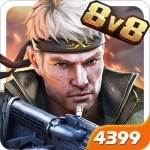
Blaze of Strike
Games and Entertainment
App
Blaze of Strike brings you the fairest FPS multiplayer experience on mobile phone for free! Relieve...

Xcite by Alghanim Electronics
Shopping and Lifestyle
App
Enter the exciting world of Xcite by Alghanim Electronics and start your online shopping. Browse and...

Snake and ladder: Board battle
Games and Entertainment
App
Snakes and Ladders is the simplest and best time Passing game with lots of fun! Main Feature:...
